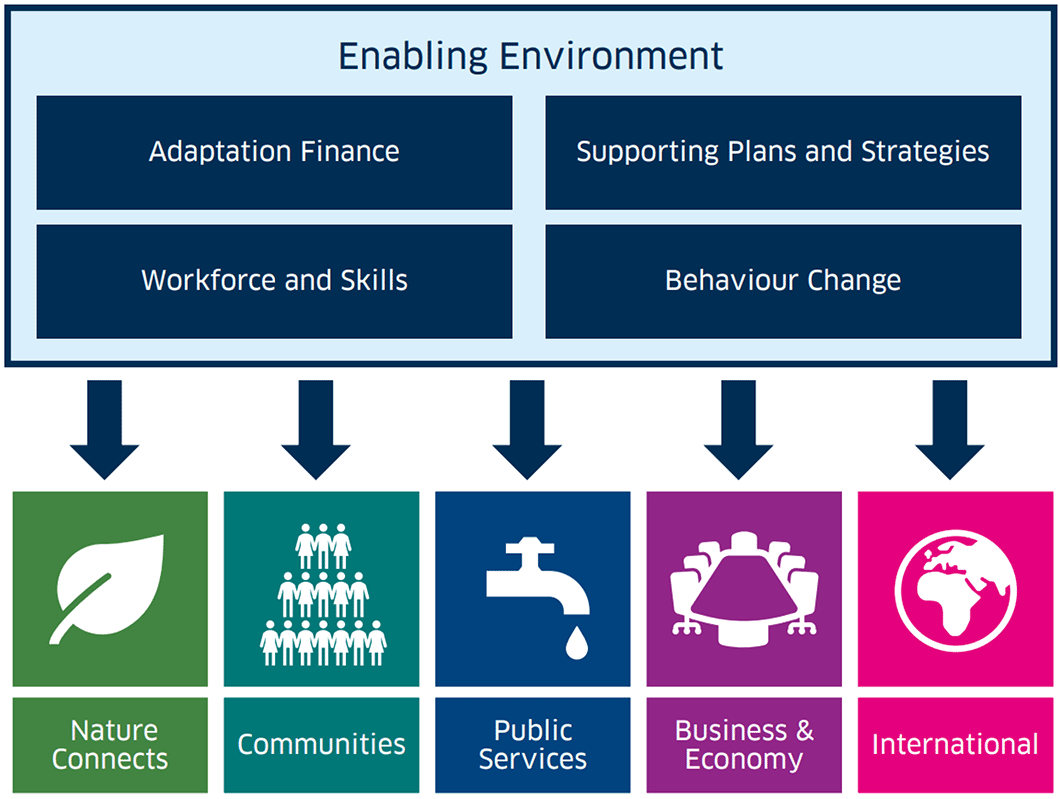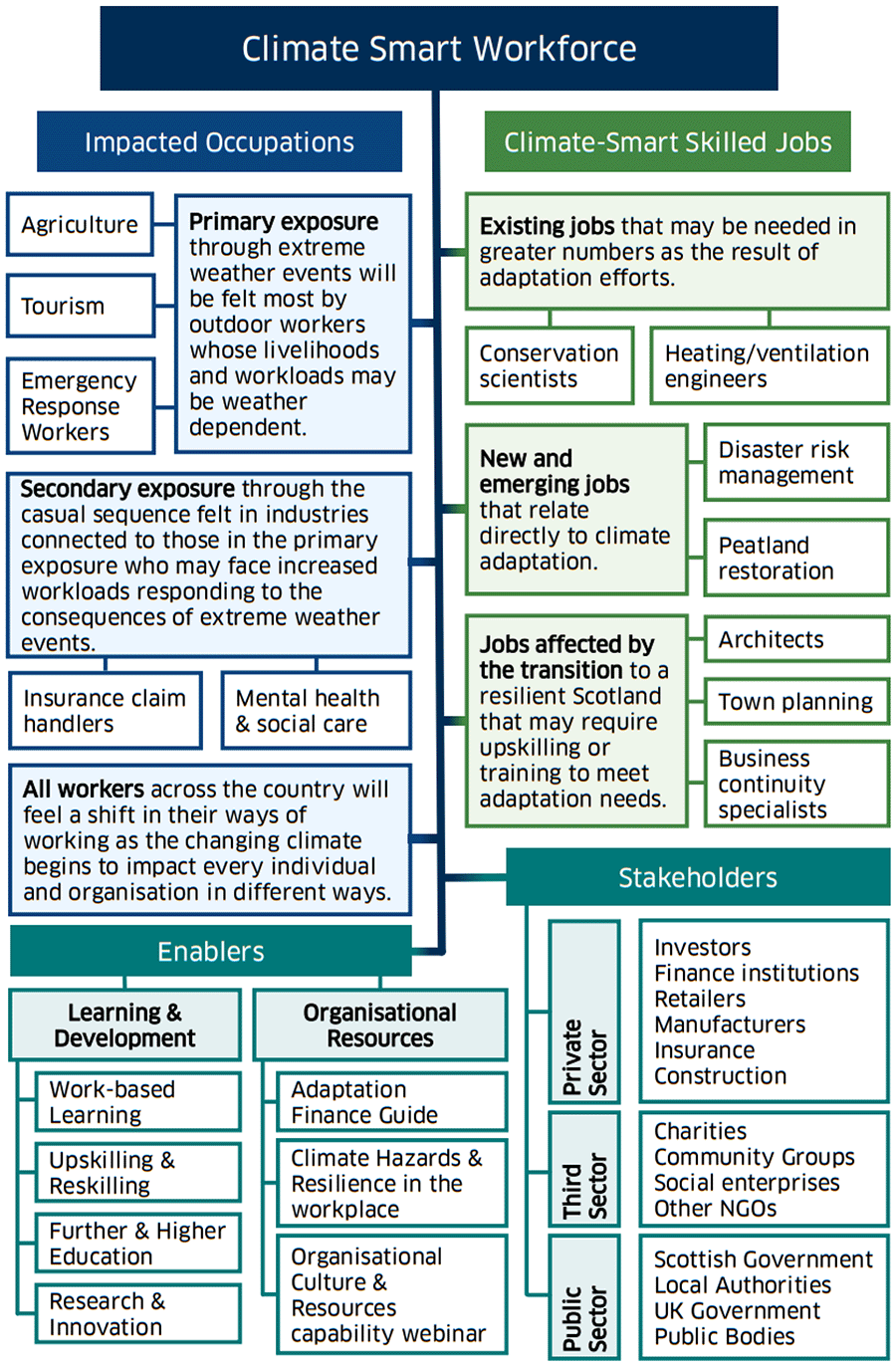Climate change: Scottish National Adaptation Plan 2024-2029
Sets out the actions that the Scottish Government and partners will take to respond to the impacts of climate change. This Adaptation Plan sets out actions from 2024 to 2029.
Supporting All Of Scotland’s Priorities
Without adaptation, Scotland’s aspirations for economic success, poverty reduction, nature and high-quality public services will be undermined by the effects of climate change. But actions to address climate impacts can deliver multiple co-benefits for health, wellbeing, equity, economic growth, jobs and biodiversity.
Figure 2 maps the Scottish Government plans and strategies critical to delivering inclusive and effective adaptation action during the Adaptation Plan five-year implementation period. Figure 3 outlines the particularly important enabling factors for effective adaptation action.
Figure 2: Scottish Government plans and strategies critical to delivering inclusive and effective adaptation action during the Adaptation Plan five-year implementation period (2024 – 2029)
Supporting Plans and Strategies:
- National Strategy for Economic Transformation
- Agriculture Reform Programme
- NHS Scotland Climate Emergency and Sustainability Strategy
- Transport Scotland's Approach to Climate Change Adaptation and Resilience
- Learning for Sustainability
- Biodiversity Strategy
- Flood Resilience Strategy
- Place Principle
- Climate Change Plan
- Just Transition Plans
- National Planning Framework
Enabling adaptation
Without making changes in our daily lives and having the appropriate skills and finance, Scotland will not build resilience to climate change in a way that is fair and equitable. Each of these factors will be instrumental towards successful delivery on the Plan’s five outcomes:
- Adaptation finance
- Workforce and skills
- Behaviour change approach
Adaptation finance
Finance will be key to unlocking Scotland’s resilience to the impacts of climate change.
Adaptation, and our vision for a more climate resilient Scotland, will require financing a range of actions. Investment will be needed to reduce potential damages from immediate climate hazards and in anticipation of more severe changes to come. This means investment in infrastructure is required to build resilience to the immediate impacts of flooding and coastal change, but also to climate-proof our transport and water systems long-term, to build capacity across sectors and to restore nature and biodiversity.
The scale, breadth and diversity of adaptation action to be financed presents a significant challenge. The Climate Change Committee anticipate that the UK needs to spend between an additional £5 billion and £10 billion per year on adapting to climate change, across both the public and private sector. An early estimate for Scotland suggests that an additional £1.8 billion is required by 2030 (Climate Emergency Response Group, 2023).

The enabling environment consists of factors that need to be in place to achieve the outcomes and objectives in SNAP3.
Enabling Environment
- Adaptation Finance
- Workforce and Skills
- Supporting Plans and Strategies
- Behaviour Change
Bridging this adaptation finance gap at the pace required to limit the greatest costs to Scotland, will require efficient use of public funds. It will also require mobilising responsible private investment, including through new financing structures which appropriately blend public and private funding. Policies to support finance strategies over the Adaptation Plan are set out in Objective B4.
Economic analysis has shown that while upfront investments costs may be high, proactive investments in adaptation can save money in the long term and reduce the costs of damage from future climate impacts. For instance, it is estimated that for every £1 spent on protecting communities from flooding, around £9 in property damages and wider impacts can be avoided (UK National Audit Office, 2019).
Our efforts to strengthen our assessment of the investment required for Scotland is also set out in Objective B4. This includes how we will work to understand the economic costs and benefits of adaptation interventions, with a case study on investing to adapt our trunk road network.
Workforce and skills
Our labour market is already shifting in response to the climate emergency (see Figure 4). There are variations in the demand for current skills, and new and emerging green jobs are being created. In order to achieve the outcomes within this Adaptation Plan, we need a system of lifelong education, research and skills, that fosters curiosity, nurtures talent, encourages ambition and enables everyone to fulfil their potential. Where people face insecure work or threats to livelihoods due to climate change, skills development opportunities will be increasingly important.
Scotland’s post-school education and skills system plays a key role in supporting individual learners and employers, in all communities, to adapt their skillset to the changing climate. Our transition to a more climate resilient Scotland will also rely on consideration of the principles of community wealth building and fair work first.
Policy detail supporting this can be found in Outcome 3 in relation to Scotland’s learning curriculum and learning estates; and in Outcome 4 in relation to private sector capacity building from the Adaptation Scotland programme, fair work and trade union engagement, and community wealth building.

Climate Smart Workforce
Impacted Occupations
Primary exposure through extreme weather events wiII be felt most by outdoor workers whose livelihoods and workloads may be weather dependent.
- Agriculture
- Tourism
- Emergency Response Workers
Secondary exposure through the casual sequence felt in industries connected to those in the primary exposure who may face increased workloads responding to the consequences of extreme weather events.
- Insurance claim handlers
- Mental health & social care
All workers across the country will feel a shift in their ways of working as the changing climate begins to impact every individual and organisation in different ways.
Climate-Smart Skilled Jobs
Existing jobs that may be needed in greater numbers as the result of adaptation efforts.
- Conservation scientists
- Heating/ventilation engineers
New and emerging jobs that relate directly to climate adaptation.
- Disaster risk management
- Peatland restoration
Jobs affected by the transition to a resilient Scotland that may require upskilling or training to meet adaptation needs.
- Architects
- Town planning
- Business continuity specialists
Enablers
Learning & Development:
- Work-based Learning
- Upskilling & Reskilling
- Further & Higher Education
- Research & Innovation
Organisational Resources:
- Adaptation Finance Guide
- Climate Hazards & Resilience in the workplace
- Organisational Culture & Resources capability webinar
Stakeholders
Private Sector:
- Investors
- Finance institutions
- Retailers
- Manufacturers
- Insurance
- Construction
Third Sector:
- Charities
- Community Groups
- Social enterprises
- Other NGOs
Public Sector:
- Scottish Government
- Local Authorities
- UK Government
- Public Bodies
Behaviour change approach
A full behaviour change approach to climate adaptation can be found in Annex C. Instances of adaptation behaviours can be found across the Adaptation Plan, with at least 12 the policies directly relying upon individuals or communities taking action. Examples of behaviours under four of the five outcomes include:
- Nature Connects: Individuals planting trees in their local area, or taking part in local restoration activities.
- Communities: Communities co-creating adaptation learning programmes; individuals greening their gardens or installing property flood resilience, such as flood covers.
- Public Services and Infrastructure: Individuals correctly disposing of household items and of fats, oils and greases rather than flushing them down the toilet
- Economy, Business and Industry: Farmers optimising their irrigation methods.
Yet there is low public awareness of why and how people in Scotland need to adapt to a changing climate (CAST, 2023). Many people are also sceptical as to the impact they can have as an individual, and by the costliness of certain resilience measures (Ibid).
In delivering this Adaptation Plan, the Scottish Government will consider people’s knowledge, attitudes, and behaviours in relation to adapting to climate change, alongside research capturing communities’ lived experiences. This will be analysed through behavioural models such as the COM-B model and the Behaviour Change Wheel (Michie et al, 2011) to balance the range of policy levers needed to support the uptake of adaptation behaviours. This includes the policy levers which consultation respondents felt would best enable them to take action, namely: resilient infrastructure; guidance and regulation; community engagement and initiatives; and communications.
The Scottish Government will work to improve the public’s understanding of climate risks, how to take action, and the impacts of that action. There will be a particular focus on the co-benefits of doing so – if somebody de-paves their garden, for example, it both helps to prevent localised flooding, and offers the wellbeing benefits of being amongst natural green space.
Finally, the Scottish Government will take a place-based approach to adaptation. This will mean exploring opportunities for neighbourhoods to shape and implement interventions, working towards a society where climate resilience is the norm.
Contact
There is a problem
Thanks for your feedback